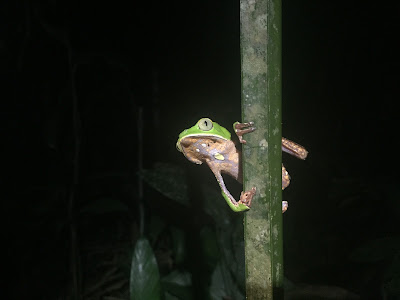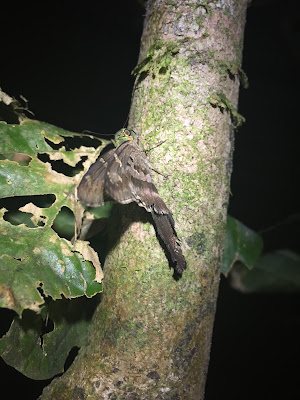I do not necessarily think that pictures can ever tell a story as adequately as words. At the same time, if your wordsmithing abilities are not perfect, pictures can help a lot. Think of this blog post as a slideshow, because that is how I chose to write it!
We saw a coral snake!!! This is Micrurus lemniscatus. We were super excited to see it, and it proved that...
"The night is dark and full of terrors."
- The Red Woman, Game of Thrones
And more terrors.
This frog (Engystomops freibergi) is terrified!
Awwwww. Alright, so for a few weeks I assisted a Master's student from James Watling's lab of John Carroll University (Cleveland, Ohio). Her name is Julia, she is from Brazil, and we will be labmates this Fall! After I found out that I was chosen for the gig at Kaieteur National Park, Guyana (see a couple blog posts ago) I got in touch with Dr. Watling, which led to me helping Julia with her project in the Brazilian state of Rondônia (pronounced Hone-done-eeya). Rondônia is located in western Brazil and is at the forefront of Amazonian deforestation. While this sounds depressing, I tried to think of it as a great opportunity to see some of the remaining forest before it disappears. Okay, that is very depressing. Though the tiny patch of forest we worked in looks like a dot on the map, it actually contains impressive biodiversity. We saw a few monkey species, many reptiles and amphibians, and we were told that jaguars frequent the area! I was only involved in the beginning phases of Julia's project, but I definitely got a lot out of it, including seeing many Phyllomedusa (vaillantii and camba), which are among the goofiest and most charismatic frogs in existence!
Ridiculous, right?
I was involved in the setup and monitoring of 24 quadrat plots (8m x 8m squares) during my three weeks of work. Setup meant carrying a bunch of huge wooden stakes out into the forest, pounding them into the ground at the corner of each plot, and painting them white so we could locate them at night. The monitoring took place four out of every five nights thereafter. The monitoring was simply ~30 minutes of searching in a quadrat for all the frogs and lizards. And yes, we worked at night, as tends to be the case in my line of work. Occasionally you see really unexpected things at night, like porcupines (no photos) and this bird, which we found asleep on its perch. We also collected some environmental data in the daytime, which made our workdays/nights quite long (10-15 hours!).
Carrying the aforementioned stakes for plot setup was sweaty work. Butterflies took notice and fed off my gross shirt.
As I mentioned before, we saw lots of Phyllomedusa (vaillantii this time). This species has a rough ridge behind each of its uniquely silver eyes.
You cannot even comprehend how many moths we battled every night. As the only source of light in a patch of rainforest, you tend to have them flutttering jn your face like crazy. But occasionally you see cool ones, like this moth that looks very wasp-like. We also had wasps terrorize us at times...
Another Phyllomedusa looking unamused.
An Allobates (type of poison frog). Only saw a handful of these quick little dudes.
To reach the quadrats where we did our monitoring work, we walked on a long trail. This is where we often found snakes, perhaps because they were unable to hear us crashing through vegetation. This is an Imantodes cenchoa! Can you tell I was excited about it? They are terrific climbers and can support much of their slim body with on anchor point, as seen here.
Score: Fungus-1, Moth-0
WHY IS JULIA HANDLING A CORAL SNAKE?! Just kidding. This is a false coral snake (Rhinobotrum lentidinosum). It just mimics them as a defense mechanism. We saw two of these in one night! We believe they were seeking each other out to mate...
More awesome Phyllomedusa action.
I somehow caught this big Kentropyx during one of our nightly surveys! These guys are wicked fast, so it required a dive to the ground for me to capture it.
In our rare free time we enjoyed some of Brazil's finest foods, like this fried ball of goodness with a hardboiled egg in the middle. Skol is one of the many watered down light beers I enjoyed during the daytime heat.
Butterflies are actually much more annoying than moths, at least at night. These skippers were the absolute worst! They are cute though.
I clearly had a favorite frog.
I mean, look at that face!
This Cercosaura oscellata was like an eel in the leaf litter, but I got it!
Osteocephalus (taurinus and oophagus) were also a common sight along the trails. These big treefrogs can get pretty large, but most notably, they have the most intricately detailed irises of any animal I have seen!
The termites took over this wooden stake (left). This is what a rainforest looks like at night!
This is a daytime shot of the forest canopy from below.
Perhaps my best Phyllomedusa photo.
Total digression. There are vineyards in Rondônia! I tried to buy their wine. Sadly, they only had stuff from other parts of Brazil. Yeah, I cannot explain how that makes any sense.
Julia found this lovely Dendropsophus leucophyllatus! Few frogs are more vibrant in color. We took a million photos.
Rainforest trail in the daytime. You can see that the understory here was pretty thick. We had to walk through this crap every night, then crouch and crawl through it to look for animals! No wonder I found so many ticks!
I believe this is some kind of tortoise beetle - a GOLDEN one! I had no idea this was possible.
Longhorn beetle, not too different from what I used to find as a kid in Oregon.
Dragonflies might take the cake for most annoying night-time insect! They just crash into your face until they tire out or die...
It was weird to see an edge to the rainforest. Rondônia is full of edges, as well as tiny island-like patches of forest. Between these forest patches is pasture land for cattle, along with the occasional vineyard.
This seriously used to be solid rainforest. My gut reaction is to get upser about this. But the economy of Brazil is driven by beef to a large degree. Hopefully that will change in a way that benefits both the people and the environment. They need each other to survive.
Mega butterfly likely preparing to attack my face.
Colorful grasshopper 1.
Colorful grasshopper 2.
Cute little Scinax on a twig. Another common sight.
This is our caiman friend! We saw it on a regular basis when we crossed a small creek that it called home. The species is Paleosuchus trigonatus.
PASTEL! Deep-fried and filled with ground beef. Sooo good!
Another Imantodes cenchoa sitting on a leaf! They are so skinny that even the smallest plants can support their weight.
I was overdue for another one of these...
And another. This one is Phyllomedusa camba, as evidenced by the dark eyes and lack of ridges behind the eyes.
This is a Hypsiboas fasciatus that needs to chill out.
Coleodactylus amazonicus, a tiny gecko that we found almost every night!
They are cute.
Marmitex, also known as takeaway food. We got this from a gas station restaurant most of the time. There is a lot of rice hiding under there! I was surprised that it was FAR superior to any gas station food in the US.
The devastation was both sad and beautiful at times. In a rainforest you never get views.
That Hypsiboas fasciatus finally chilled out! Look at the crazy latticework it has for an eyelid!
Amazon Tree Boa (Corallus hortulanus) being very coily. We saw it hanging from a tree over the trail. As we stood below, it got curious and lowered itself down to our level. Boas are "muito boa" (very good, in Portuguese).
Spider eating a grasshopper... This is a good reminder of the brutality of nature. Notuce how the spider is the size of the leaf. Also, it is hiding on the underside. I am so glad I never (knowingly) brushed up against such a leaf!
Tiny gecko amazingness! Can you believe that this is an adult?
One last Phyllomedusa for you! In the end, I had a lot of fun scraping around the forest floor with Julia! We found a lot of interesting creatures, and she taught me a ton about Brazilian culture, as well as a smattering of Portuguese words and phrases. This was not your typical toursity jaunt to Rio's beaches, yet it left a good impresion. I certainly plan to visit Brazil again in the near future! My visa is good for 10 years, so I should take advantage.




















































